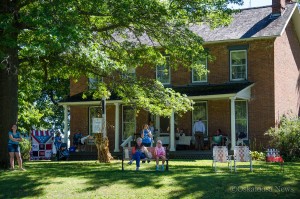50 Years Of Bringing The Past To Life

Hundreds of visitors flocked to Nelson Pioneer Farm on Saturday for their 50th Annual Fall Festival. (photo by Ginger Allsup/Oskaloosa News)
Oskaloosa, Iowa — The sound of hooves on the street, the boom of a black powder rifle, mixed with many other sights, sounds and smells made up the 50th Annual Fall Festival at the Nelson Pioneer Farm.
The event has transformed over the decades, where it originally started out as a multiday vendor fair which drew upward of 7,000 people to the gem on the prairie. “It’s amazing how it’s changed over the years,” said Nelson Pioneer Farm Curator Kelly Halbert.
Over the years, the different curators have had different goals for the festival, but for Halbert, helping to bring the history to life and in the visitors hands is something she finds most important.
“When they started 50 years ago, people were remembering. Now, people have no reference to what we’re doing. How many kids have even shucked an ear of corn, let alone made a doll out of it,” asked Halbert. “We do need to do hands on, because demonstrating doesn’t really teach it.”
Halbert thinks the hands on is more fun and allows visitors to become more involved, “and you occasionally get somebody who gets hooked.”
“That’s the whole goal, the whole purpose is to get somebody hooked into a new craft, into a new interest.”
“My goal is if somebody will enjoy it for five minutes, maybe they’ll go home and read a book about it, watch a DVD, learn more, and suddenly have a new hobby,” says Halbert.
Being active with a hobby and/or a craft is exemplified by one of the demonstrators that comes to the farm every year for the festival. Milt has been making rope at the festival for 27 years now. “He has people coming out that have 26 ropes and they have to get their 27th,” says Halbert. “That’s what’s fun.”
At Nelson Pioneer Farm, they do demonstrate up to 1959 on the farm itself, because that’s when the farm was gifted to the historical society. The majority of the crafts demonstrated at the farm are focused between the years of the 1880s to the 1930s.
As time goes along, some skills and crafts have been lost, because those that have done them are now passing away. With their passage goes the skills and knowledge that was passed to them. Halbert gave an example of corn husk caning. “Nobody does that anymore.”
“The more we lose them, the more we forget them,” Halbert says of those lost skills.
Beyond farm equipment, the facility has an extensive collection of historical structures from around the county, including a general store, meeting house and a home from a mining town called Buxton.
The Mahaska County Historical Museum, which is located at the Nelson Pioneer Farm, is collecting and preserving today’s artifacts for tomorrow’s generations. “People have a funny idea in their heads that if I’m living it can’t be history. Well yesterday is history,” says Halbert.
But when the farm and museum started, shortly after World War II, not many items were collected from those individuals because of that same mentality. It wasn’t history to those who had fought and served. “Well now, 60 years later, I’m struggling to find artifacts from that era to share and to teach with,” explained Halbert. “We have nothing or very, very little from Vietnam and very little from Iraq. When I talk about wars, I don’t have the tools to tell that story.”
“I collect anything that fits Mahaska County history,” says Halbert.
If you have any questions about the Nelson Pioneer Farm, or the Mahaska County Historical Society, you can find their website HERE, or their Facebook page HERE.















